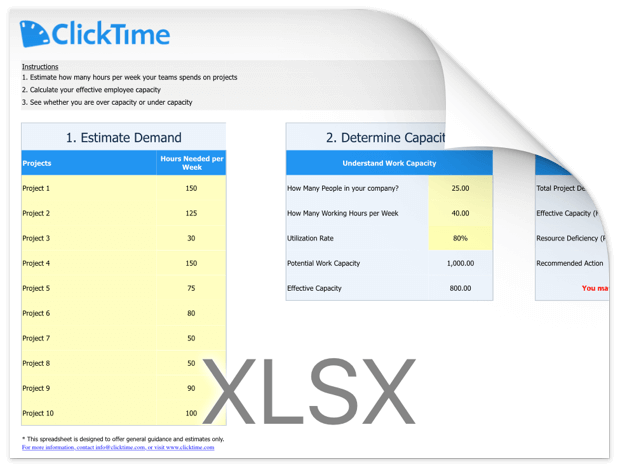6 Benefits of Capacity Planning for Any Organization
Table of Contents
Time management expert Alan Lakein once wrote, “Planning is bringing the future into the present so that you can do something about it now.”
Lakein was referring to planning as a cornerstone of personal productivity. However, planning is also a critical part of running an efficient business. And smart, well thought-out plans become even more crucial when you’re looking to grow your business.
Many organizations take planning seriously when it comes to projects and budgets. After all, you need to know what work you’re taking on, how much it costs, and what your profit margins are.
But once you have your projects and budgets mapped out, you need to take it one step further. And that’s where capacity planning comes in.
What is Capacity Planning?
Capacity planning is the process of considering your existing and upcoming projects, their budgets, and your staff to make sure your current team members can handle their work you’re going to assign to them.
For example, if you’ve won multiple projects, you need to know how long they’ll take and whether you have enough employees to complete the work on time. You also need to know how much each employee’s labor costs on a project to make sure you come in on — or even under — budget.
Working efficiently becomes even more important as you grow your business, whether that means taking on more projects or hiring more staff. The more moving parts you have to consider, the more necessary capacity planning becomes.
6 Benefits of Capacity Planning
There are many strategies that can help you grow your business. But capacity planning encompasses project management, budgeting, and staffing — three critical aspects of managing your business. Keep reading to understand exactly how your business can benefit from capacity planning.
1
Make Data-informed Decisions
When you lay out everything in a resource planning tool — whether that’s a spreadsheet or capacity planning software — you can see how your projects, budgets and staff connect. And seeing all that information in one place helps you make decisions based on concrete data.

Jacek Ptak, CEO & Founder of Krakow Direct
“Imagine analysing tons of spreadsheets to find out how to allocate your resources. That’s simply a waste of time. Instead, you’re able to track the progress in real-time, along with invaluable insights.”
As Jacek Ptak, CEO & Founder of Krakow Direct, describes it, capacity planning allows you to “be in total control of your company by keeping your hand on the pulse.” With all the relevant data on hand, you can make informed decisions about taking on new projects, pricing out your company’s work, and bringing on new employees or clients.
2
Budget more intelligently
Over-servicing clients is an easy way to go over budget. Capacity planning can help you:
- Avoid putting in more costly labor hours than necessary on a given project.
- Eliminate uncomfortable conversations with clients about unexpectedly high invoices.
- Justify negotiations when asking for a budget or rate increase.
When you understand how much each employee’s labor costs for each project, you can make smarter decisions about staffing and assignments. For example, entry-level employees with lower billing rates can work on low-lift tasks. Then you can save expensive, experienced employees’ hours for more complex, high-level work.
Understanding everyone’s labor costs will help you assign the right people to the right projects at the right time while still sticking to your clients’ budgets.
3
Avoid Burnout and Boredom
Caroline Lee, marketing director at CocoSign, says that after CocoSign implemented capacity planning, they “realized that understaffing leads to employee exhaustion and poor staff retention, while overstaffing can be costly.”

Caroline Lee, Marketing Director at CocoSign
“We realized that understaffing leads to employee exhaustion and poor staff retention while overstaffing can be costly.”
Capacity planning helps you make sure you have enough staff to complete your projects without working them overtime. It also helps make sure that your current team has enough to do so they feel challenged at work. And finally, it helps your bottom line by ensuring that employees aren’t tacking costly busywork onto projects just so they have something to do.
By laying out all of your expected project hours in a capacity planning tool and comparing them to the hours you can expect from your staff, you can keep employees happy, avoid constant team shifts and new hires, and make sure you’re not overservicing.
4
Stay on Top of Skills
Part of capacity planning should also include a skill inventory so you know which employees can complete which tasks. Many organizations keep track of skills informally. For example, they can expect all junior staff to work at a certain level, while senior-level employees can work on more complex tasks.

Tal Shelef, Realtor and co-founder of CondoWizard
Resource planning enables resource managers to consider the team members’ skills and interests before task allocation hence, enhances the team engagement on every project and assures improved productivity.”
Understanding your team’s skillset can help you ensure that you always have the right amount of knowledgeable employees on hand for difficult or high-stakes work. It can also help you make sure you employ the right amount of (cheaper) junior staff to complete basic tasks.
Ptak, of Krakow Direct, also points out that understanding skills boosts employee morale. He says that employees “became much happier” when they were “assigned to the most suitable tasks.”
Tal Shelef, realtor and co-founder of CondoWizard, agrees, saying that considering “team members’ skills and interests before task allocation enhances team engagement on every project and assures improved productivity.”
5
Make Better Hiring Decisions
With a better understanding of your project workload, your team’s availability, and the skills available to your company, you can make smarter hiring decisions.

Neal Taparia, Founder of Imagine Easy Solutions
“A planning system assigns your available resources and finds the best fit for a task based on skill, availability, cost, experience, qualification, location, etc.”
If you’re debating whether to take on a new project, you’ll be able to see immediately if your current staff has enough time to take it on. And if you realize your team lacks a skill you know would be useful, you can better evaluate whether you need to hire a contractor for a specific project or whether a new full-time hire would be useful for long-term work.
6
Leave Time to Grow
When you know you have the right amount of people with the right skills to complete your projects, you can start considering your company’s future.

Patrick Marzurkiewicz, CEO & Founder of WirEntsorgen
“Finding some time for training is critical and lets you retain employees more effectively, as people like to learn new things.”
Patrick Mazurkiewicz, CEO and founder of WirEntsorgen, points out that understanding your current capacity allows you “to allocate time for learning and development for your employees.” He adds, “Your team needs to improve, or you’ll simply be left behind your competition. Finding some time for training is critical and lets you retain employees more effectively, as people like to learn new things.”
With the necessary time budgeted for billable work, you can keep everyone happy by ensuring there’s still time to improve. Employees will appreciate the opportunity to expand their skillsets. Clients will love the new services you’ll be able to provide and the level of expertise each of your employees has. And let’s be honest, you’ll love how satisfied clients and employees will impact your profit margins.
Start capacity planning for your organization
Capacity planning will help you feel more confident in how your business is run. With the ability to see project workloads and budgets and the availability of your staff, you’ll be able to make smarter decisions more quickly.
You’ll understand when you can take on more work without decreasing quality or increasing team burnout. And you’ll know when to hire new team members or focus on skill development based on the work you need to get done.
If you’d like to experience the benefits of capacity planning for yourself, you can get started by downloading a free capacity planning template. Or if you think you’ll need something more powerful than a spreadsheet, look into ClickTime’s Resource Planning Tool. Using your employees’ timesheet data, Resource Planning helps you automate project budgets and time spent on each project.
Learn more about how ClickTime Resource Planning can work for you.








